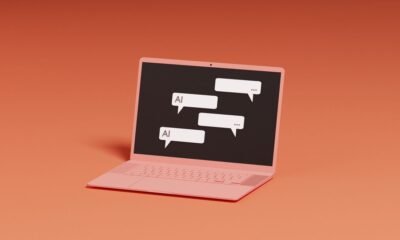Education
How Educators Can Catch Up

AI can help teachers and students
Students are racing ahead with artificial intelligence while their teachers struggle to keep pace. Recent data confirms this trend. According to Statista, 63% of U.S. teens use AI tools like ChatGPT for school assignments, while only 30% of teachers report feeling confident with these same tools. This mismatch creates real problems: students may misuse AI while teachers struggle to provide meaningful guidance.
The solution isn’t banning AI or hoping it disappears. Teachers need practical skills to utilize these tools effectively and guide students toward ethical and productive AI use.
The Problem: What The AI Skills Gap Looks Like
The AI skills gap manifests differently across classrooms, but common patterns emerge that create real challenges for both teachers and students.
Detection Focus Over Education. Teachers often confuse AI detection with AI education. Many educators focus on catching students who use AI rather than teaching them to use it well. This approach misses the opportunity to develop critical digital literacy skills.
Policy Confusion Creates Chaos. One teacher allows AI-assisted brainstorming, while another prohibits the use of AI altogether. Students navigate these mixed messages without clear guidance about appropriate AI applications.
Training Lags Behind Adoption. Districts invest in AI tools but provide minimal training. Teachers receive new platforms without the support needed to implement them effectively.
Why This Matters: The AI Stakes For Students And Teachers
Effective AI education requires teacher leadership. Students need adults who understand both the capabilities and limitations of AI. When teachers lack AI literacy, they are unable to help students navigate ethical considerations or develop critical thinking about AI outputs.
Consider the entrepreneurship program I run, WIT—Whatever It Takes. We created an AI platform called WITY that our teens can use to support their entrepreneurial journey. Our teenage entrepreneurs are increasingly utilizing AI for business planning, market research, and content creation. They work with AI-literate mentors to learn to verify information, understand biases, and combine AI insights with human judgment. Students without this guidance often accept AI outputs uncritically.
The same principle applies in traditional classrooms. Teachers who understand AI can help students use it as a learning tool rather than a replacement for thinking. They can design assessments that encourage AI collaboration while testing genuine understanding.
This matters beyond academic success. Research from the World Economic Forum indicates that AI literacy will be essential for most careers by 2030. Students need early exposure to AI tools combined with education about their appropriate use.
The Solution: Five Essential AI Skills For Teachers
Based on my work with educators and young entrepreneurs, teachers need specific competencies to guide students effectively:
1. Prompt Engineering Fundamentals: Teachers should understand how to craft clear, specific requests that produce useful AI outputs. This skill enables them to utilize AI effectively and teach students to do the same.
2. Bias Recognition and Critical Evaluation: All AI systems reflect the biases present in their training data. Teachers need to spot these limitations and help students develop healthy skepticism about AI responses.
3. Tool Selection and Evaluation: With hundreds of AI tools available, teachers must learn to identify which ones are appropriate for educational use, considering factors such as age appropriateness, privacy policies, and educational value.
4. Creative Curriculum Integration: AI works best when integrated thoughtfully into the existing curriculum, rather than being treated as a separate subject. Teachers can use AI to generate discussion prompts, create differentiated materials, or provide personalized feedback.
5. Assessment Adaptation: As AI capabilities continue to expand, traditional testing methods become increasingly less effective. Teachers need strategies for assessing student learning in an AI-enhanced environment, focusing on application, analysis, and original thinking rather than merely recalling information.
Getting Started: Practical AI Steps Teachers Can Take Today
Teachers don’t need extensive technical training to begin developing AI literacy. Small, consistent steps build confidence and competence over time.
Start With Personal Experimentation. Teachers can use ChatGPT to brainstorm lesson ideas, create quiz questions, or generate examples for complex concepts. This hands-on experience fosters familiarity without the pressure of a classroom setting.
Join Educator AI Communities. Online groups, such as the Facebook AI for Education community or Twitter hashtags like #AIinEd, provide practical tips and real-world classroom examples. These communities offer peer support and shared learning opportunities.
Focus On One Tool At A Time. Rather than trying to master multiple AI platforms, teachers can start with one tool and thoroughly explore its capabilities. This builds confidence and provides a foundation for learning additional tools.
Document What Works. Teachers should keep simple notes about successful AI applications and share them with colleagues. This creates institutional knowledge and encourages broader adoption.
Building AI Support: What Schools And Districts Can Do
Individual teacher initiative matters, but systemic support accelerates progress. School and district leaders can implement several effective strategies to close the AI skills gap.
Provide Ongoing Professional Development. AI tools evolve rapidly, so teacher training must be continuous. Monthly sessions are more effective than annual conferences for developing practical skills.
Develop Clear AI Policies. Teachers need frameworks for the appropriate use of AI that encourage experimentation while establishing clear boundaries and guidelines. These policies should address both the use of AI by teachers and students.
Create Collaboration Opportunities. Teachers learn best from peers who share similar challenges and experiences. Professional learning communities focused on AI integration enable educators to share successes and collaborate on troubleshooting problems together.
Allocate Time For Experimentation. Teachers need dedicated time to explore AI tools without pressure to implement them immediately. This exploration time reduces anxiety and builds genuine competence.
The Bigger Picture: Preparing Students For An AI Future
Teacher AI literacy serves a larger purpose than improving classroom efficiency. Students today will work in careers where AI collaboration is standard. They need adults who can model thoughtful AI use and help them develop critical evaluation skills.
At WIT, I see young entrepreneurs who use AI effectively because they learned to combine artificial intelligence with human creativity and judgment. They verify AI outputs, understand limitations, and apply critical thinking to AI-generated ideas.
Teachers who use AI thoughtfully can guide students toward productive AI partnerships that enhance rather than replace human capabilities.
Moving Forward: The AI Choice Is Ours
The AI skills gap in education won’t close automatically. It requires intentional action from individual teachers, schools, and educational systems. But the effort pays dividends for both educators and students.
Teachers who develop AI literacy report increased efficiency in lesson planning, more personalized instruction capabilities, and better preparation for supporting student learning. Students benefit from adults who can guide their use of AI toward productive and ethical applications.
The goal isn’t making teachers into AI experts. It’s helping them become confident users who can guide students effectively. This starts with curiosity, continues with experimentation, and grows through practice and peer collaboration. Technology will continue advancing whether teachers participate or not. The choice is whether educators will lead this change or struggle to catch up. For the sake of students who need thoughtful AI guidance, teachers must choose to lead.
Education
Threat—or The Wake-Up Call Education Needed?

The student writes their essay in class by hand instead of using AI to generate the essay.
getty
Schools across America are scrambling to ban ChatGPT and implement policies to detect AI-generated homework. Teachers are worried about cheating. Parents are demanding clarity on AI policies. Districts are investing millions in detection software.
The panic might be missing the real opportunity. The opportunity to revisit teaching methods that have proven more effective than worksheets and standardized tests, and can’t be AI-generated.
How AI Exposes Weaknesses in Current Teaching Methods
When a chatbot can draft a five-paragraph essay in seconds or complete a worksheet in less than a minute, those assignments lose their purpose. With AI in the mix, familiar assessments no longer give teachers a clear picture of what students actually know or how they think. This moment is forcing schools to ask a bigger question: if old methods no longer work, what does?
The solution isn’t necessarily something new. It lies in practices that have stood the test of time but were often sidelined in the push for efficiency. Now, the rise of AI is making them essential again. Three stand out: the Socratic method, handwritten work completed in class, and oral assessment. Together, these approaches reveal genuine understanding while cultivating the skills students need most in the AI era: critical thinking, creativity, and communication.
AI vs. Socratic Method
The Socratic method, which involves questioning students until they reach a more profound understanding, was education’s gold standard for 2,500 years. Modern classrooms abandoned it for efficiency, but the AI usage crisis is bringing it back with urgency.
Students can’t outsource thinking to a chatbot when facing live questions. Can they explain why their solution works? Can they apply concepts to new scenarios? Can they defend their reasoning when challenged? These abilities separate genuine learning from superficial knowledge regurgitation.
McKinsey research indicates that 87% of executives consider strong verbal communication and critical thinking the most valuable employee traits, which is precisely what Socratic dialogue develops. Tech companies like Google and Apple now include “Human-AI collaboration skills” in job descriptions, but they still require humans who can think independently and communicate complex ideas clearly.
The method works across subjects. Math teachers who use Socratic questioning report that students develop stronger problem-solving skills than those who learn through traditional problem sets. History teachers find that students retain information longer when they must argue different historical perspectives aloud. Science teachers observe improved experimental design when students are required to defend their hypotheses verbally.
Implemented well, the Socratic method transforms classrooms into spaces where students don’t just recall information; they know how to think critically.
AI vs. The Hidden Power of Handwriting
Typing may be faster, but neuroscience shows it isn’t always better for learning. Recent research using brain imaging has revealed that handwriting activates a broader network of the brain—including areas associated with memory, motor control, and language—than typing does. This broader engagement helps students encode information more effectively. Since handwriting takes more time, it also forces students to paraphrase and process ideas rather than transcribe. The result is deeper comprehension, stronger retention, and more original thought, outcomes that ChatGPT can’t replicate.
A reflective journal written by hand during class gives teachers a far more authentic snapshot of a student’s thought process. Likewise, in-class essays done with pen and paper reveal genuine understanding rather than the polished but hollow output AI can produce.
Schools that have reintroduced handwritten assignments report higher engagement and more original thinking. Students may resist at first about giving up laptops, but many quickly realize they think more clearly without digital distractions.
The benefits extend well beyond authenticity. Handwriting slows the pace of thinking just enough to encourage deeper processing, better retention, and more original ideas, outcomes that typing, and indeed AI, rarely deliver.
AI vs. Oral Assessment
Oral defense of ideas may sound old-fashioned, but it remains one of the most powerful tools in education. The moment students explain a concept aloud, their level of understanding becomes clear. Teachers can press further, ask sharper questions, and evaluate learning in real time.
This approach is spreading across K-12 classrooms, where schools report not only higher test scores but also an increase in student confidence. Teachers consistently note that when students must articulate concepts verbally, they reach a deeper level of understanding than written work alone reveals.
Oral assessments also surface insights that traditional tests miss. Students bring in personal experiences, cultural knowledge, and unique perspectives that enrich the classroom and give teachers a fuller sense of how each learner thinks. Research published in the Journal of Statistics and Data Science Education found that students who regularly engage in oral assessments demonstrate stronger achievement on complex reasoning tasks compared to peers evaluated only through written exams.
Unlike essays or worksheets, this is an area where AI can’t step in. A chatbot can generate a polished response, but it can’t think on its feet, adjust to follow-up questions, or show genuine confidence in the moment. Oral assessments force students to practice adaptability, clear communication, and critical reasoning.
While oral exams take more time than written tests, the payoff is undeniable. They provide a more accurate measure of comprehension, give students freedom of expression, and build the kind of confidence and communication skills that last well beyond school. Far from outdated, oral assessments are one of the most effective tools we have to cultivate both competence and connection in the classroom.
AI as Catalyst, Not Catastrophe
AI isn’t the end of education; it’s the wake-up call schools needed. It exposes the cracks in systems built on essays, worksheets, and standardized tests, and points us back toward practices that actually help students learn.
The Socratic method, handwriting, and oral assessment demand skills no chatbot can fake: curiosity, adaptability, creativity, and emotional intelligence. They also give teachers a more accurate sense of student comprehension and understanding.
Education’s role has never been to produce content; it’s to cultivate thinkers. If we’re willing to see it, AI may be the disruption that helps us do that better than ever.
Education
Artificial intellegence on London Morning: The changing landscape of AI in education

Artificial intelligence isn’t just a subject for researchers and tech companies anymore; it’s becoming part of daily life.
That’s why London Morning is launching a new monthly column on AI with Mark Daley, Western University’s Chief AI Officer. The first conversation focused on how the technology is already shaping education and what it means for students, teachers and families.
Daley said AI should be seen as a “general-purpose technology,” comparing it to electricity or running water, something that eventually becomes woven into every corner of society and used in many different ways. In education, AI is being used in the classroom, in labs, and even in risk management situations.
However, much of the public attention is focused on how students are utilizing AI in their schoolwork. Daley said students can be trained to use AI for everything from study help to meal planning, but the emphasis is always on values.
“Ask yourself: am I using this to make me better? Did I write the essay myself and use AI for feedback, or did I have it write the whole essay so I could go out with friends? One of those makes you better, the other doesn’t,” Daley said.
When it comes to catching AI-written work today, Daley said it is nearly impossible.
“If the student is even moderately competent at prompting and proofreading, then you have no hope of knowing. It’s actually mathematically impossible to be certain.”
LISTEN | Artificial intelligence with Western’s Mark Daley on London Morning:
London MorningThe good use of AI in the classroom comes down to values
London Morning’s first AI column delves into the use of artificial intelligence in the classroom. Western University chief AI officer Mark Daley told London Morning there is more to using AI than writing students an essay — it can be used to help students improve their skills.
Daley noted that younger students are also experimenting with AI, but often get mixed messages about whether it’s useful or just “cheating.” He said banning it outright wouldn’t work; instead, parents and teachers should guide students back to their values and ask how the tools can be used to build skills, rather than bypass them.
Looking ahead, Daley believes AI will be as essential as reading and writing.
“The expectation, whether you’re going for a job or higher education, is going to be that you know how to use this tool effectively,” he said.
As a parent himself, Daley advises families not to make the conversation about “shiny technology,” but back to the focus on values. “How can you use this technology to live those values, not rob you of them?”
He also shared a practical tip for those who haven’t yet tried AI: pick a platform like ChatGPT or Microsoft Copilot, and experiment by automating the three tasks you dislike most about your job.
“It might not solve all of them,” Daley said. “But it could help with one or two, and in the process, you’ll learn how to use it.”
London Morning’s AI column with Mark Daley will air monthly, with the next segment on Tuesday, Oct. 14, at 7:35 a.m. You can tune in at 93.5 FM, online at cbc.ca/London, or on the CBC News app.
Education
School absence a big factor in child mental illness in England, data shows | School attendance and absence

School absences “significantly contribute” to children’s mental ill health, according to research backed by the Office for National Statistics (ONS) that shows the risks increase the longer a child is absent.
“Our research shows that the more times a child is absent from school, the greater the probability that they will experience mental ill health,” the authors, from Loughborough University and the ONS, concluded.
The study, involving more than 1 million school-age children in England, found the relationship between absence and mental health was “a two-way street”, with lengthy absences increasing the likelihood of later hospital treatment. It also found children with existing mental health problems took more time off school.
Experts called for further research to find out what initially causes the poor attendance, with secondary schools in England recording persistently high rates of absence since the Covid pandemic of 2020-21.
Louise Vesely-Shore of the ONS said: “This work suggests that absence from school can have a detrimental effect on some young people’s mental health. We also found that young people with mental health issues had a higher level of absence from school.
“But for students with mental ill health who received additional support at school, such as education, health and care plans, free school meals and Send support, the increase in absence was lessened.
“More work is needed to understand this better, but clearly schools can play a vital role in supporting some students with mental health conditions.”
One of the study’s main findings was the proportion of hospital visits related to mental ill health rose more rapidly among children who were the most persistently absent.
While fewer than two in every 100 children and young people with full school attendance made hospital visits for mental health difficulties, the rate was nearly four in 100 among those absent for more than 20% of the time, and more than five in 100 among those with a 30% absence rate.
The impact of each increase in absence was found to be worse for girls than for boys, while children with special educational needs and disabilities (Send) almost doubled their probability of mental ill health for every 1% increase in absence when compared with their peers without special needs.
However, the effect of mental ill health on school attendance was slightly improved for children with certain forms of Send support, while those receiving support for moderate or severe learning difficulties, or speech, language and communication needs, had better levels of attendance.
While the research looked at family circumstances and other contributing factors, it did not distinguish between reasons for absence, such as illness or bullying, that could be contributing factors.
The researchers examined the school records and census data of 1.1 million children in England aged five- to 16 and living at home with two parents.
Dr Simona Rasciute of Loughborough University, who led the analysis for the ONS, said: “This is the first large-scale data-linkage initiative in England to connect children’s education and health records with both of their parents’ health records and socioeconomic characteristics, alongside household and neighbourhood factors.
“This innovative work has allowed us to uncover new insights into the drivers of the children and young people’s mental health crisis in England.”
The Department for Education says getting more pupils attending school regularly is a “top priority” for the government. In 2023-24, one in five pupils in England were classed as “persistently absent” after missing 10% or more school lessons.
-

 Business2 weeks ago
Business2 weeks agoThe Guardian view on Trump and the Fed: independence is no substitute for accountability | Editorial
-
Tools & Platforms4 weeks ago
Building Trust in Military AI Starts with Opening the Black Box – War on the Rocks
-

 Ethics & Policy1 month ago
Ethics & Policy1 month agoSDAIA Supports Saudi Arabia’s Leadership in Shaping Global AI Ethics, Policy, and Research – وكالة الأنباء السعودية
-

 Events & Conferences4 months ago
Events & Conferences4 months agoJourney to 1000 models: Scaling Instagram’s recommendation system
-

 Jobs & Careers2 months ago
Jobs & Careers2 months agoMumbai-based Perplexity Alternative Has 60k+ Users Without Funding
-

 Education2 months ago
Education2 months agoMacron says UK and France have duty to tackle illegal migration ‘with humanity, solidarity and firmness’ – UK politics live | Politics
-

 Education2 months ago
Education2 months agoVEX Robotics launches AI-powered classroom robotics system
-

 Podcasts & Talks2 months ago
Podcasts & Talks2 months agoHappy 4th of July! 🎆 Made with Veo 3 in Gemini
-

 Funding & Business2 months ago
Funding & Business2 months agoKayak and Expedia race to build AI travel agents that turn social posts into itineraries
-

 Podcasts & Talks2 months ago
Podcasts & Talks2 months agoOpenAI 🤝 @teamganassi



















